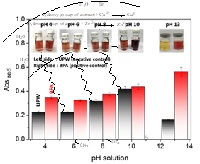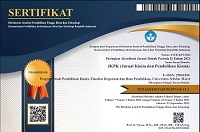
A Simple Colorimetric Detection of Bisphenol A in Exposed Drinking Bottles Using a Paper-Based Sensor
Abstract
Keywords
Full Text:
PDFReferences
[1] V. McGovern, "Polycarbonate plastics and human BPA exposure: urinary levels rise with use of drinking bottles," Environ. Health Perspect., vol. 117, no. 9, p. A406, Sep. 2009, doi: 10.1289/ehp.117-a406b.
[2] Y. Xiong et al., "BPA-free? Exploring the reproductive toxicity of BPA substitutes BPS and BPF on endometrial decidualization," Ecotoxicol. Environ. Saf., vol. 287, p. 117275, Nov. 2024, doi: 10.1016/j.ecoenv.2024.117275.
[3] J. O. Ighalo et al., "Bisphenol A (BPA) toxicity assessment and insights into current remediation strategies," RSC Adv., vol. 14, no. 47, pp. 35128–35162, Nov. 2024, doi: 10.1039/d4ra05628k.
[4] D. Ginter-Kramarczyk, J. Zembrzuska, I. Kruszelnicka, A. Zając-Woźnialis, and M. Ciślak, "Influence of temperature on the quantity of bisphenol A in bottled drinking water," Int. J. Environ. Res. Public Health, vol. 19, no. 9, May 2022, doi: 10.3390/ijerph19095710.
[5] G. Fadillah, S. Triana, U. Chasanah, and T. A. Saleh, "Titania-nanorods modified carbon paste electrode for the sensitive voltammetric determination of BPA in exposed bottled water," Sens. Bio-Sens. Res., vol. 30, p. 100391, Dec. 2020, doi: 10.1016/j.sbsr.2020.100391.
[6] S.-H. Nam, Y.-M. Seo, and M.-G. Kim, "Bisphenol A migration from polycarbonate baby bottle with repeated use," Chemosphere, vol. 79, no. 9, pp. 949–952, May 2010, doi: 10.1016/j.chemosphere.2010.02.049.
[7] F. S. Vom Saal and L. N. Vandenberg, "Update on the health effects of bisphenol A: Overwhelming evidence of harm," Endocrinology, vol. 162, no. 3, Mar. 2021, doi: 10.1210/endocr/bqaa171.
[8] M. E. Cull and L. M. Winn, "Bisphenol A and its potential mechanism of action for reproductive toxicity," Toxicology, vol. 511, p. 154040, Feb. 2025, doi: 10.1016/j.tox.2024.154040.
[9] X. Xie et al., "BPA exposure enhances the metastatic aggression of ovarian cancer through the ERα/AKT/mTOR/HIF-1α signaling axis," Food Chem. Toxicol., vol. 176, p. 113792, Jun. 2023, doi: 10.1016/j.fct.2023.113792.
[10] H. Dilnashin, D. Singh, P. Roy, R. K. Tyagi, and S. P. Singh, "Advances in analytical methods for BPA detection in commercial milk: Current techniques and future prospects," J. Food Compos. Anal., vol. 139, p. 107029, Mar. 2025, doi: 10.1016/j.jfca.2024.107029.
[11] A. B. Bashir and A. A. Audu, "Determination of bisphenol A released from polycarbonate infant feeding bottles by UV-VIS spectrophotometry," J. Chem. Soc. Niger., vol. 45, no. 6, Nov. 2020, doi: 10.46602/jcsn.v45i6.555.
[12] C.-E. Pop et al., "Bisphenol A analysis and quantification inconsistencies via HPLC-UV: A systematic review with technical notes," Discov. Appl. Sci., vol. 6, no. 4, p. 171, Mar. 2024, doi: 10.1007/s42452-023-05617-z.
[13] K. Owczarek et al., "Validated GC–MS method for determination of bisphenol A and its five analogues in dietary and nutritional supplements," Microchem. J., vol. 180, p. 107643, Sep. 2022, doi: 10.1016/j.microc.2022.107643.
[14] M. Chen et al., "Determination of bisphenol-A levels in human amniotic fluid samples by liquid chromatography coupled with mass spectrometry," J. Sep. Sci., vol. 34, no. 14, pp. 1648–1655, Jul. 2011, doi: 10.1002/jssc.201100152.
[15] J. Kochana et al., "Tyrosinase-based biosensor for determination of bisphenol A in a flow-batch system," Talanta, vol. 144, May 2015, doi: 10.1016/j.talanta.2015.05.078.
[16] V. Ragavan K, N. Rastogi, and M. Thakur, "Sensors and biosensors for analysis of bisphenol-A," TrAC Trends Anal. Chem., vol. 52, pp. 248–260, Dec. 2013, doi: 10.1016/j.trac.2013.09.006.
[17] D. Voutsa, "Analytical methods for determination of bisphenol A," in Plastics in Dentistry and Estrogenicity: A Guide to Safe Practice, T. Eliades and G. Eliades, Eds. Berlin, Germany: Springer, 2014, pp. 51–77.
[18] R. Hidayat, S. Wahyuningsih, and G. Fadillah, "Green synthesis approach to produce TiO2/rGO nanocomposite as voltammetric sensor for monitoring trace level bisphenol-A," Mater. Sci. Eng. B, vol. 286, p. 116083, Dec. 2022, doi: 10.1016/j.mseb.2022.116083.
[19] P. Kumar, Shimali, S. Chamoli, and K. R. Khondakar, "Advances in optical and electrochemical sensing of bisphenol A utilizing microfluidic technology: A mini perspective," Methods, vol. 220, pp. 69–78, Dec. 2023, doi: 10.1016/j.ymeth.2023.11.004.
[20] L. A. Putri et al., "Review of noble metal nanoparticle-based colorimetric sensors for food safety monitoring," ACS Appl. Nano Mater., Aug. 2024, doi: 10.1021/acsanm.4c04327.
[21] G. K. Mahunu, N. A. Afoakwah, and H. E. Tahir, "Fundamentals of colorimetric sensors for food quality and safety," in Colorimetric Sensors, Academic Press, 2024, pp. 17–35.
[22] S. Mansouri et al., "Recent progress of smartphone-assisted paper-based analytical devices (PADs) for multiplex sensing," Microchem. J., vol. 209, p. 112670, Feb. 2025, doi: 10.1016/j.microc.2025.112670.
[23] E.-H. Lee, S. K. Lee, M. J. Kim, and S.-W. Lee, "Simple and rapid detection of bisphenol A using a gold nanoparticle-based colorimetric aptasensor," Food Chem., vol. 287, pp. 205–213, Jul. 2019, doi: 10.1016/j.foodchem.2019.02.079.
[24] S. Medici et al., "An updated overview on metal nanoparticles toxicity," Semin. Cancer Biol., vol. 76, pp. 17–26, Nov. 2021, doi: 10.1016/j.semcancer.2021.06.020.
[25] C. Li and J.-B. Baek, "Recent advances in noble metal-based electrocatalysts for hydrogen evolution reaction," ACS Omega, vol. 5, no. 1, pp. 31–40, Jan. 2020, doi: 10.1021/acsomega.9b03550.
[26] J. Ma et al., "Dual-mode sensing platform for bisphenol A detection via bifunctional CsPbBr3@Cu-MOF," Anal. Chim. Acta, vol. 1332, p. 343354, Dec. 2024, doi: 10.1016/j.aca.2024.343354.
[27] W. Cheng et al., "Applications of MOF-based sensors for food safety," Trends Food Sci. Technol., vol. 112, pp. 268–282, Jun. 2021, doi: 10.1016/j.tifs.2021.04.004.
[28] A. Khataee et al., "State-of-the-art progress of MOF-based sensing platforms for bisphenol A," Environ. Res., vol. 212, p. 113536, Sep. 2022, doi: 10.1016/j.envres.2022.113536.
[29] A. Sakthivel et al., "Recent advances in schiff base metal complexes from 4-aminoantipyrine derivatives," J. Mol. Struct., vol. 1222, p. 128885, Dec. 2020, doi: 10.1016/j.molstruc.2020.128885.
[30] Y. Fiamegos, C. Stalikas, and G. Pilidis, "4-Aminoantipyrine spectrophotometric method of phenol analysis," Anal. Chim. Acta, vol. 467, no. 1, pp. 105–114, Sep. 2002, doi: 10.1016/S0003-2670(02)00072-7.
[31] T. Yu et al., "Catalytic effect of K3Fe(CN)6 on hydrogen production from coal electro-oxidation," Electrochim. Acta, vol. 83, pp. 485–489, Nov. 2012, doi: 10.1016/j.electacta.2012.08.010.
[32] M. M. A. Nigjeh and M. Askarzadeh, "Green and inexpensive method to recover bisphenol-A from polycarbonate wastes," Polímeros, vol. 23, Feb. 2013, doi: 10.1590/S0104-14282013005000019.
[33] L. Jiang et al., "Cellulose-derived supercapacitors from carbonisation of filter paper," ChemistryOpen, vol. 4, Jul. 2015, doi: 10.1002/open.201500150.
Refbacks
- There are currently no refbacks.








